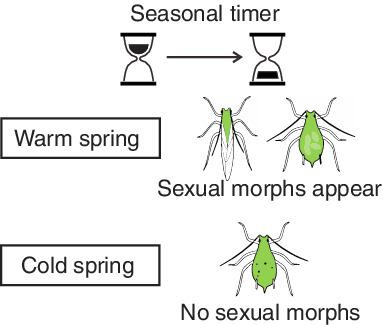当前位置:
X-MOL 学术
›
Physiol. Entomol.
›
论文详情
Our official English website, www.x-mol.net, welcomes your feedback! (Note: you will need to create a separate account there.)
Suppression of autumnal sexual morph production in spring by a seasonal timer in an aphid
Physiological Entomology ( IF 1.5 ) Pub Date : 2020-05-20 , DOI: 10.1111/phen.12322 Naoki Matsuda 1 , Takashi Kanbe 2 , Jun Endo 1 , Shin‐Ichi Akimoto 2 , Hideharu Numata 1
Physiological Entomology ( IF 1.5 ) Pub Date : 2020-05-20 , DOI: 10.1111/phen.12322 Naoki Matsuda 1 , Takashi Kanbe 2 , Jun Endo 1 , Shin‐Ichi Akimoto 2 , Hideharu Numata 1
Affiliation

|
Photoperiod is the major seasonal cue for phenotypic plasticity in the regulation of development and reproduction. Aphids have a peculiar mechanism in which sensitivity to the photoperiod is lost for a few months through successive generations after hatching from diapause eggs, and therefore, the mechanism responsible for the photorefractory period is termed “a seasonal timer”. However, whether the seasonal timer has adaptive significance has never been investigated. Here, we show that the photorefractory generation avoids an unseasonal sexual morph production under short days in spring in the pea aphid, Acyrthosiphon pisum (Harris). When the seasonal timer operated, the overwintered generation, stem mothers, produced only parthenogenetic progenies under natural photoperiods and temperatures in both warm and cold springs. After repeated parthenogenesis following diapause, however, aphids with an expired seasonal timer produced sexual females and males typical of autumn under natural photoperiods and temperatures in a warm spring. These sexual morphs are thought to have a reproductive disadvantage compared to parthenogenetic morphs in the following summer. We thus conclude that the seasonal timer is adaptive for avoiding sexual morph production in spring. The present study shows, for the first time, that a photorefractory period lasting over generations is a trait of ecological importance.
中文翻译:

季节性定时器抑制蚜虫春季春季秋季性形态的产生
在发育和繁殖的调控中,光周期是表型可塑性的主要季节性提示。蚜虫有一个特殊的机制,即从滞育卵孵化后,对光周期的敏感性会在连续几代后的几个月中失去对光周期的敏感性,因此,将光致不应期的机制称为“季节性定时器”。但是,从未对季节计时器是否具有适应性意义进行过研究。在这里,我们表明,photorefractory代避免下短短几天的反常性变形生产春天的豌豆蚜虫,豌豆蚜(哈里斯)。当季节性定时器运行时,越冬的一代,干母,在自然光周期和温度下,无论是在暖泉水还是冷泉中,仅产生孤雌生殖后代。滞育后反复单性生殖,但是,在自然光周期和温暖的春季温度下,具有过期季节性定时器的蚜虫会在秋季产生典型的雌性和雄性。与第二年夏季孤雌生殖的性行为相比,这些性行为被认为具有生殖缺陷。因此,我们得出的结论是,季节性计时器可以避免春季出现性形态变化。本研究首次表明,持续数代的光致不应期是具有生态重要性的特征。
更新日期:2020-05-20
中文翻译:

季节性定时器抑制蚜虫春季春季秋季性形态的产生
在发育和繁殖的调控中,光周期是表型可塑性的主要季节性提示。蚜虫有一个特殊的机制,即从滞育卵孵化后,对光周期的敏感性会在连续几代后的几个月中失去对光周期的敏感性,因此,将光致不应期的机制称为“季节性定时器”。但是,从未对季节计时器是否具有适应性意义进行过研究。在这里,我们表明,photorefractory代避免下短短几天的反常性变形生产春天的豌豆蚜虫,豌豆蚜(哈里斯)。当季节性定时器运行时,越冬的一代,干母,在自然光周期和温度下,无论是在暖泉水还是冷泉中,仅产生孤雌生殖后代。滞育后反复单性生殖,但是,在自然光周期和温暖的春季温度下,具有过期季节性定时器的蚜虫会在秋季产生典型的雌性和雄性。与第二年夏季孤雌生殖的性行为相比,这些性行为被认为具有生殖缺陷。因此,我们得出的结论是,季节性计时器可以避免春季出现性形态变化。本研究首次表明,持续数代的光致不应期是具有生态重要性的特征。



























 京公网安备 11010802027423号
京公网安备 11010802027423号